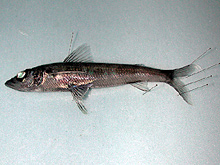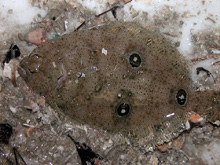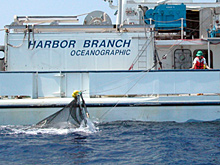
Samples of muscle tissue from fish such as this greeneye are being collected to help untangle the complex food webs in the marine environment. Click image for larger view.
What’s for Dinner?
August 21, 2003
Jim Berg
Biologist
U.S. Geological Survey
A primary long-range research goal of the “Life on the Edge” science team is to define fish and invertebrate community structures down the shelf/slope depth gradient and across geographic regions along the slope of the southeastern United States. During this cruise, buckets of marine organisms of all shapes, sizes, colors and compositions are being collected each day via a multitude of means, including the manned submersible dives, discrete depth tucker trawl tows, neuston and plankton net tows, dip netting, and hook-and-line sampling. These collections come into the wet lab to be worked up or catalogued for examination back on shore. A specific objective of this expedition is to collect information about the benthic habitats as well as the water column above them. Scientists hope these data will provide a glimpse at the community structure of these poorly understood habitats off the coast of North Carolina.
A primary aspect of marine ecosystem dynamics and community structure is predator-prey relationships (i.e., trophic interactions, the exchange of energy in relation to food webs). These interactions are not only about who eats who but also where each "who" originates from. For example, phytoplankton may be eaten by zooplankton in the photic zone, which can be eaten by small mid-water fish when they are foraging nearer to the bottom. In turn, while foraging, the small mid-water fish may be eaten by larger bottom-dwelling fish. Each step in this food chain can be classified as a predator-prey interaction.
One widespread approach to understanding these complex interactions is stomach content analysis. To do this, scientists must remove or flush the stomach of an individual organism, in this case the predator (consumer). They can examine the stomach contents to gain insight into what the individual has been eating. What is found in the gut tells you a story about where an animal has been foraging and what it has been foraging on. Unfortunately, stomach content analysis only shows you what has recently been ingested. Another drawback is the difference in breakdown time between hard versus soft-bodied prey items. If, for example, a crab and sponge were ingested at the same time, the crab’s shell would certainly stick around a lot longer than the sponge would.

Chief Scientist Ken Sulak and Watch Chief Ann Marie Necaise examine the catch from a recent neuston net tow. Samples collected via this method often contribute to the stable isotope “tissue bank." Photo credit: Kristin Heron. Click image for larger view.
Scientists on this expedition are using stable isotope analysis as a tool to more definitively identify the feeding habits of organisms and their habitat use/preferences over long periods of time. We collect a bit of muscle tissue from certain organisms for this analysis. Prey items that would otherwise break down within the stomach of a consumer too quickly to be recognized through stomach content analysis can still be identified using stable isotope analysis. This works because the food that one eats leaves a signature (a sort of "fingerprint") within one’s own tissue. This signature is an indicator of what was eaten and from where it was derived.
Stable isotope signatures remain in the tissue of organisms due to the nature of atomic weights and the way that organisms’ systems break down differently weighted atoms. Through analysis of these signatures in the tissue, we can learn the details of an organism’s long-term diet, its habitat preference based on the origin of its food supply, and its position in the food chain or on the trophic ladder, i.e., the “who eats who” part of a food web

Three-eyed flounders, whose cryptic coloration allows them to blend into their environment, are often worked up for stable isotope analysis. Photo credit: Liz Baird. Click image for larger view.
The data gained from stable isotopes can be used in conjunction with stomach content analysis, and, together, these data can begin to reveal new information about the world of food-web interactions. One day we hope to achieve a comprehensive understanding of the food habits of marine-based consumers at all levels on the trophic ladder off the Carolinas. When complete, it may help shed light on the overall ecosystem dynamics and the mechanisms behind the community structure throughout the water column along the gradient of the continental shelf and continental slope here.






















